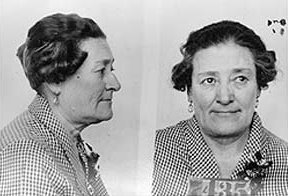The Botched Execution of Eva Dugan, 1930
Home | Rediscovered Crime News | The Botched Execution of Eva Dugan, 1930The following article might explain why the first woman executed in Arizona also became the last woman executed in Arizona. Let’s just say, it did not go as planned. She was sentenced to hang for the murder of a rancher she was employed with after his buried body was miraculously discovered 11 months after the murder. According to a Wikipedia article, she was married five times and all of her husbands disappeared. Assuming she killed them, a safe assumption, that would make her a serial killer.
[STATE PRISON, Florence, Ariz., Feb. 21, 1930, Associated Press] —Mrs. Eva Dugan, the first woman to be legally executed in Arizona, paid with her life on the gallows shortly before dawn today for the slaying in 1927 of A. P. Mathis, Tucson rancher. The trap was sprung at 5:02 a. m. As the trap clanged and she dropped more than six feet, the noose tightened, severing her head, and the body catapulted to the floor. Dr. L. A. Love, prison physician, pronounced her dead immediately.
Warden Lorenzo Wright immediately cleared the gallows room, and turned the body over to the prison physician and an undertaker. Six women witnessed the execution.
Mrs. Dugan, unshaken, calmly climbed the 13 steps to the gallows and smiled as the black hood was adjusted over her head. She said she had no statement to make.
Warden Wright clasped her hand and said, “God bless you, Eva.” Mrs. Dugan smiled and said “good-bye, Daddy Wright.”
A few seconds later the steel trap was sprung and Eva Dugan had cancelled her debt to society for the crime of which she was convicted.
Warden Lorenzo Wright created a sensation a few minutes before the hanging by revealing to newspaper men the discovery of what he believed was a plot by Mrs. Dugan to cheat gallows by taking poison before she was removed to the death chamber.
Acting on a tip that the woman had procured a poison dose, Wright said he transferred her from her prison cell to the condemned chamber about 1 a.m. A search of the abandoned cell, the warden said, led to the discovery beneath a mattress of a 2 ounce bottle of a “deadly poison.”
The bottle, he said, bore the label of a Florence drug store. A search of her person a few minutes later disclosed three safety razor blades. Wright said the woman apparently intended to commit suicide but was prevented from taking it by the vigilance of guard. An investigation has been begun to explore the source of-the poison and razor blades.
The 52-year-oid housekeeper, who was convicted of the murder of Mathis, her employer, in January, 1927 in order to gain possession of his property, spent the hours preceding her execution in the company of the prison chaplain and a few friends. Until after midnight she sat at a card table and played whist with two women friends and a woman prisoner, while outside her cell the death watch paced back and forth.
Occasionally she reached out to caress a telegram which lay on the table—a farewell message form her daughter, Mrs. Cecil Loveless, During the course of the game, Mrs. Dugan requested that her “guests,” be served with orangeade. Several minutes passed before the drink was served, and the condemned woman called to a guard: “please bring on the orangeade. I want it now. Tomorrow will be too late.”
Since early evening the sky had been overcast, and a light rain was pattering on the graveled pathway as the woman was led from her cell to the prison proper across an open-space to the death cell. She smoked a cigarette and joked with guards as she marched along and as they neared the gallows house she laughed and sang “I don’t know where I’m going, but I’m on my way.”
She kissed two of the guards who left her at the door of the death house and said: “I love everyone connected with the prison. You have all been good to me, and I can’t blame you for what the law is going to do to me.” The guards were store visibly affected than was the woman who stood in the shadow of the scaffold.
A telegram delivered to her in the condemned cell revealed a hitherto unknown chapter of her early life. The message, signed “Ada ostapple, (sic) Seattle, Wash., Read: “I sympathize with you and have the greatest admiration for your bravery and grit.”
“Ada is an old friend of the Yukon days,” Dugan said, “Probably you didn’t know it, but I was one of those who followed the gold rush into the Yukon.”
Mrs. Dugan will be buried in the prison graveyard, in a shroud of white silk which she made herself. Several weeks ago she purchased a casket and paid an undertaker to prepare her body for burial.
Her 82-year-old father, William McDaniels, of Ceres, Calif., was unable to grant her wish to be with her during the hours preceding her death. She ref used to disclose the name of her son, and the name of her daughter was not revealed until the message came from her last night.
Mrs. Dugan was convicted of murdering A. J. Mathis, an aged rancher, on the desert near Tucson, about two years ago.
Mathis was last seen alive Jan. 14 1927 about a month after he had employed Mrs. Dugan as housekeeper. A few days previously Mrs. Dugan and a mysterious “Jack,” a 17-year-old boy, left the ‘Mathis ranch and dropped from sight.
“Jack” is just a name as far as the accumulated record of three years is concerned. He appeared on the Mathis ranch a day or two before Mathis’ disappearance and has not been seen since.
Following Mathis’ disappearance, Mrs. Dugan, after attempting to sell a cow and some chickens on the ranch, left in a coupe owned by Mathis, in company with “Jack.” It is believed that this young man, whose last name has never been learned, was employed by Mrs. Dugan to drive the car.
Mrs. Dugan and the boy first went to Amarillo, Tex. where she sold the coupe for $600, signing the papers “Eva Mathis.” The boy signed “A. J. Mathis.” There Mrs. Dugan bought tickets to Kansas City.
After discovery of the body of Mathis on December 11, 1927 by J.F. Nash, an Oklahoma machinist, who had selected the precise spot where the body was buried to drive a tent stake, Mrs. Dugan was arrested at White Plains, N. Y., returned to Tucson and convicted of first degree murder. She was originally sentenced to be hanged June 1, 1928, but obtained a stay of execution upon appeal to the state supreme court Dec. 1929. The supreme court affirmed the judgment of conviction and resentenced her to be hanged Feb. 21, 1920, exactly two years from the date her trial began.
Last month an application was made to the board of pardons and paroles for commutation of the death sentence to life imprisonment. Following a hearing, by a vote of two to one, the board declined to recommend commutation.
After a jury found Mrs. Dugan sane, the board was asked for a reprieve, which was refused.
Source: Associated Press via The Prescott Evening-Courier, Feb. 21, 1930, pages 1 & 4.
Buy it today on Amazon! 372 pages, $3.95, Free with Kindle Unlimited!
—###—
True Crime Book: Famous Crimes the World Forgot Vol II, 384 pages, Kindle just $3.99, More Amazing True Crime Stories You Never Knew About! = GOLD MEDAL WINNER, True Crime Category, 2018 Independent Publisher Awards.
---
Check Out These Popular Stories on Historical Crime Detective
Posted: Jason Lucky Morrow - Writer/Founder/Editor, August 23rd, 2013 under Rediscovered Crime News.
Tags: 1930s, Arizona, bizarre, Execution, Women









